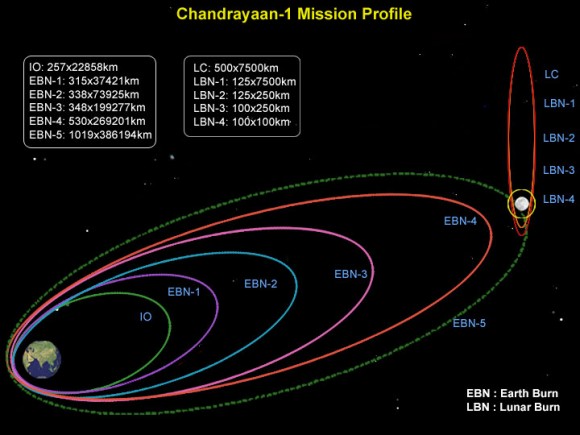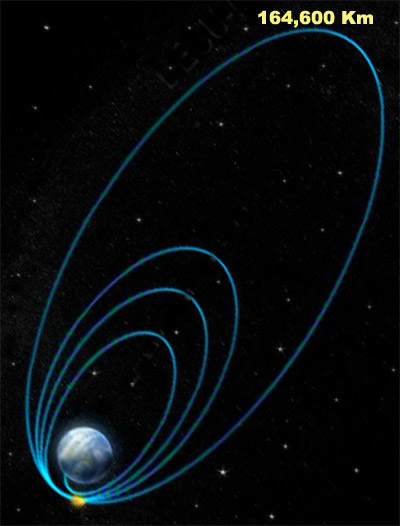After a successful maneuver early today (October 26, 2008), the Chandrayaan-1 spacecraft has crossed the 150,000 km distance mark from Earth, officially entering deep space, on course for the moon. This was the third orbit raising maneuver of the mission. The spacecraft’s 440 Newton liquid engine was fired for about nine and a half minutes, beginning at 07:08 IST. With this, Chandrayaan-1 entered a much higher elliptical orbit around the Earth. The apogee (farthest point from Earth) of this orbit lies at 164,600 km while the perigee (nearest point from Earth) is at 348 km. In this orbit, Chandrayaan-1 takes about 73 hours to go round the Earth once.
To compare, Chandrayaan’s initial orbit had a perigee of 255 km and an apogee of 22,860 km, with about a 6.5-hour period. After the second boost from its engines, Chandrayaan raised its apogee to 37,900 kilometers, and increased its orbit period to 11 hours.
Engineers from the Jet Propulsion Laboratory are also providing backup navigation assistance to the Indian Space Agency in Bangalore, India, by helping to track the flight dynamics. The antennas of the Indian Deep Space Network at Byalalu are being used for tracking and communicating with Chandrayaan-1 spacecraft in its high orbit. From the image below, you can see how additional orbit raising maneuvers in the next few days will take Chandrayaan-1 towards the Moon, and then into lunar orbit. Currently, the spacecraft is scheduled to reach lunar orbit on November 8.

Source: ISRO


Very nice article – I’d always imagined a launch to the moon as a straight shot, I’d never considered that orbital maneuvers this complicated could come into play.
Do you know if this indirect route is a matter of hardware limitations or small fuel supply?
Limited by fuel/payload considerations I suspect
NO, this is done to make it the cheapest mission ever to moon, the mission with such maneuvering makes it just half the price of a Jumbo Jet Liner.
Why to kill an elephant with a cannon when you can do same with a gun!!!!!
Well, Amit, that’s exactly what fuel/payload considerations come down to. The price tag in space missions is intimately related to the weight of the spacecraft, which in turn largely depends on the amount of fuel it needs to maneouvre and the characteristics of the payload.
So the answer would indeed be “yes”.
I’m thinking that when we sent men to the moon, they had to get there in the shortest possible time, which meant a more-or-less straight course. A robotic ship can take more time, which also might have a bearing on why they’re doing it this way.
I really hope the Indian Government Finds more than any other space agency has on the moon.
Love and Peace
Wow. Its amazing how people can figure out the wisdom in these highly complex motions. And yeah, NASA deserves this credit for their Pioneer and all. But again, humans are awesome.
Out of context but, I somehow can’t wait for the next Chandrayaan-2 missions at the end of next year.
Well……….pray for good to the man kind. I am sure that India can do much in space research. More over all the Indian people, even all the people in the world, looking for another good news that India can bring from moon and mars.
Wish all the success to the Indian scientist….ISRO….but don’t be slow…once its decided to do..then do it fast…as much….
My best regards
Yes, by sending the Space-Craft in elliptical orbits saves a lot of fuel and thus saves the Project cost with a penalty of time to reach the destination. This is absolutely OK. Soon India is going to own high resolution and precision moon maps.
Thanks,
-Vamsi
FYI – Pioneer 10 zipped past the orbit of the Moon in just 11 hours in 1972 on its way to Jupiter and eventually out of the Solar System into the Milky Way Galaxy.
yes, it would be nice to have high resolution moon maps of craters that google might have missed. plus india needs copyright-free copy of those maps like everyone else before the lunar colonies ban high resolution mapping of their spaceports, not to mention telescope viewing from the earth for security – after all, I can already see the moon from my window 🙂
can’t help being absolutely intrigued by this wonderful new “liquid engine” … MHD in space?!
Wonderful! This is the article (and the graphic) I have been looking for every since I heard of this mission UT strikes again!
We love you.
Darthsedious,
Let us be magnanimous and give due credit to India and its scientists for joining the humanity’s search for its place in the vast cosmos.
If every country had waited to wipe out all pockets of poverty on its land before before exploring the space, nothing would have happened by now. Yes India has a larger share of its poverty, but also has 300 million people whose income and lifestyle are comparable with any developed country. In the present economic meltdown, Indian economy is more stable and growing much faster unlike the economies of the large developed countries.
It is also not easy to deal with the problems of such huge population and steadily follow a democratic system.
According to the real-time tracking data on n2yo.com, the Chandrayaan-1 reached its perigee of 301.8km at Tue, 28 Oct 2008 07:03 GMT, then its apogee of 37824.4km at Tue, 28 Oct 2008 12:40 GMT, so it’s still in the 11-hour orbit? What’s wrong with it?
Could someone please tell me how humanity benfits from going to the moon again, other than nationalistic pride. I’m not being sarcastic. I would honestly like to know.
Craig,
There are hidden treasures on the moon – it has millions of tonnes of Helium – 3 isotope – which is 100s of times more fissile and cleaner than Uranium. One of the motives of this mission is to find out how abundant that element is and its commercial viability of mining.
Indeed Vishnu, if helium 3 can be processed on the moon it’s worth about 4 billion USD per tonne.
It is estimated that there is enough helium 3 on the moon to power the entire Earth for over 2,000 years, nuclear fule with no nuclear waste – could save our planet.
Shame the Japs didn’t find any water there though, but it still looks as though the space economy is heading in the right direction.
Congratulations on India’s launch!
There are some interesting videos on the http://www.moonsociety.org website that are well worth watching.
This moon mission is complete bulls**t. Vishnu, Sci-Fi Si are you for real? even if what you said were scientifically true, do you really think India, or anyone else for that matter could simply keep sending probes to the moon every month for mining? Come on guys…! This is an obvious ‘display of power’ by India, and for who’s benefit? I think providing food and basic requirements for 300 million people is far more urgent and crucial than a foolhardy trip to the moon. And I am Indian btw. I think we – as a nation – have to seriously rethink out priorities right now.
Oh and btw, great article there about orbit raising maneuvers. Thanks.
I don’t understand why people are becoming pessimistic about Indian poverty line. Rather they should become optimistic on such achievements (Chandrayaan-I). Poverty has nothing to do with Sci-fi projects. Indian poor will always remain poor as it’s an attitude problem. At least, India is going to leave some base for future generations and if it finds any success on the moon, it won’t be made limited only to Indians.
Well said sagarika-poverty is AN ATTITUDE problem just like some people here have!!!When we have religious failed societies around us-give credit to india for being a shining light!!!!
Poverty IS NOT an attitude problem… It is as real as it can get in India. Stop sweeping it under the carpet. You will know it when you have less than $1 a day to yourself. Try keeping you expenses under $1 in india for a month and then tell me if poverty is a attitude problem or not.
That said…
The cost of the mission is about US$100M… which if spent on poverty eradication programs will line the pockets of corrupt officials & politicians in India. So it is money reasonably well spent.
Those who criticize the mission should take a moment to think about the problems with Indian politics and the complexity and nature of poverty in India before opening their mouth (in this case before hitting the “submit” button).
Regardless…. Kudos to Indian scientists and India… who unlike the rich mid-east countries is spending the money on something worthwhile instead of spending on luxury hotels and man-made islands…. who these same people will rush to criticize too.
I apologize to those hearts who cry silently for the suffering of the poor in India… to whom the money spent on this project is due.
Alternatively… why can’t the Indian government pledge to match spending on poverty eradication & agriculture to that it spends in its space programs???